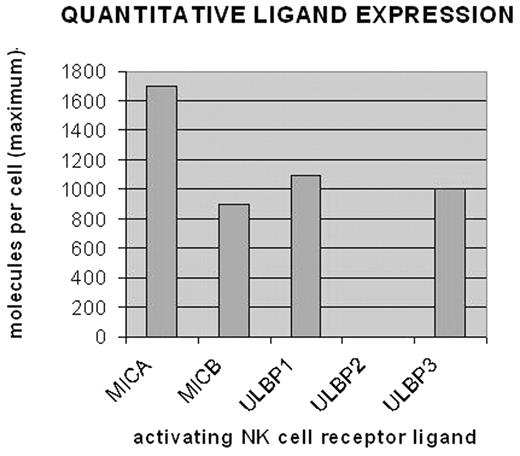Abstract
Activating and inhibitory cell surface receptors regulate natural killer (NK) cell effector functions. The extent of expression of their activating ligands on target cells probably plays a critical role in tumor immune surveillance, but the data of this expression on blasts of leukemia patients are still poor. We examined blasts of children with ALL for the activating human NKG2D ligands MICA, MICB, ULBP1, ULBP2 and ULBP3, and for the ligands of the activating human natural cytotoxic receptors (NCRs) NKp30, NKp44 and NKp46. Using ligand specific mouse monoclonal antibodies and flow cytometry, we screened 24 children (23 common-ALL, one pre-T-ALL) for the expression of NKG2D ligands and 15 children (all common-ALL) for NCR ligands. In 13 patients (all common-ALL), also the density of the NKG2D ligands was determined by quantitative flow cytometry. Considering cells positive for a particular ligand in case of a two fold increase of median fluorescence above negative control, 38 percent of the patients were positive for one or more NKG2D ligands, while only 13 percent expressed one or more NCR ligands at significant levels. ULBP1 was most frequently expressed (29 percent of patients positive), while no patients were positive for ULBP2 and NKp44 ligands. ULBP3 was positive in 17 percent of the patients, NKp30 and NKp46 ligands in 13 percent, MICA and MICB in 4 percent. The patient with pre-T-ALL was positive only for ULBP1. So ULBP1 was expressed more frequently, while the other NKG2D ligands were expressed less frequently in children than reported for adult leukemia patients before (
QUALITATIVE LIGAND EXPRESSION
QUANTITATIVE LIGAND EXPRESSION
Disclosure: No relevant conflicts of interest to declare.
Author notes
Corresponding author



This feature is available to Subscribers Only
Sign In or Create an Account Close Modal